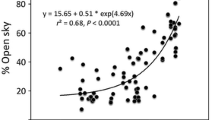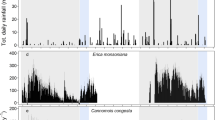Abstract
Key message
Using comparisons within and between trees, the authors show evidence for hydraulic limitation of tree height in a humid-climate species that is far from the global maximum tree height.
Abstract
We measured water status and two indicators of drought stress as a function of height within the canopies of four tall (32–35 m) eastern white pines (Pinus strobus) at an old-growth site in northern Minnesota, USA. Pre-dawn and midday xylem pressure potential measured on terminal shoots (Ψ shoot), needle length, and foliar carbon isotope discrimination (δ 13C) all showed within-canopy gradients consistent with increasing drought stress with height. Midday Ψ shoot near tree tops was −1.8 MPa, close to values associated with stomatal closure for other temperate conifers. Pre-dawn Ψ shoot decreased with height at >2× the gradient in gravitational potential. δ 13C was strongly correlated with height and weakly correlated with light. Needles were 15–25 % shorter at canopy top compared to the bottom of the canopy. Midday Ψ shoot and needle length showed significant differences in regression model coefficients from tree to tree. The patterns are consistent with hydraulic constraints on height growth of white pine at this site.






Similar content being viewed by others
References
Ambrose AR, Sillett SC, Dawson TE (2009) Effects of tree height on branch hydraulics, leaf structure and gas exchange in California redwoods. Plant Cell Environ 32:743–757
Becker P, Meinzer FC, Wullschleger SD (2000) Hydraulic limitation of tree height: a critique. Funct Ecol 14:4–11
Bond BJ, Kavanagh KL (1999) Stomatal behavior of four woody species in relation to leaf-specific hydraulic conductance and threshold water potential. Tree Physiol 19(8):503–510
Boyer JS (1969) Measurement of the water status of plants. Annu Rev Plant Physiol 20:351–364
Burgess SS, Dawson TE (2007) Predicting the limits to tree height using statistical regressions of leaf traits. New Phytol 174(3):626–636
Burnham KP, Anderson DR (2002) Model selection and multimodel inference, 2nd edn. Springer-Verlag, New York
Burns RM, Honkala BH, Tech coords (1990) Silvics of North America: 1. Conifers. Agricultural Handbook 654. U.S. Department of Agriculture, Washington D.C
Čermák J, Kučera J, Bauerle WL, Phillips N, Hinckley TM (2007) Tree water storage and its diurnal dynamics related to sap flow and changes in stem volume in old-growth Douglas-fir trees. Tree Physiol 27(2):181–198
Dawson TE, Burgess SO, Tul KP, Oliveira RS, Santiago LS, Fisher JB, Simonin KA, Ambrose AR (2007) Nighttime transpiration in woody plants from contrasting ecosystems. Tree Physiol 27(4):561–575
Duursma RA, Marshall JD (2006) Vertical canopy gradients in δ13C correspond with leaf nitrogen content in a mixed-species conifer forest. Trees 20:496–506
Ewers FW, Schmid R (1981) Longevity of needle fascicles of Pinus longaeva (Bristlecone Pine) and Other North American Pines. Oecologia 51(1):107–115
Friend AD (1993) The prediction and physiological significance of tree height. In: Solomon AM, Shugart HH (eds) Vegetation dynamics and global change. Chapman & Hall, New York, pp 101–115
Graham JS, Running SW (1984) Relative control of air temperature and water status on seasonal transpiration of Pinus contorta. Can J For Res 14(6):833–838
Hilborn R, Mangel M (1997) The ecological detective: confronting models with data. Princeton University Press, Princeton
Ishii HT, Jennings GM, Sillett SC, Koch GW (2008) Hydrostatic constraints on morphological exploitation of light in tall Sequoia sempervirens trees. Oecologia 156:751–763
Johnson JB, Omland KS (2004) Model selection in ecology and evolution. Trends Ecol Evol 19(2):101–108
Kavanagh KL, Pangle R, Schotzko AD (2007) Nocturnal transpiration causing disequilibrium between soil and stem predawn water potential in mixed conifer forests of Idaho. Tree Physiol 27(4):621–629
King DA (1990) The adaptive significance of tree height. Am Nat 135(6):809–828
Koch GW, Sillett SC, Jennings GM, Davis SD (2004) The limits to tree height. Nature 428:851–854
Lopushinsky W (1969) Stomatal closure in conifer seedlings in response to leaf moisture stress. Bot Gaz 130(4):258–263
McGilvray JM, Barnett JP (1988) Increasing speed, accuracy, and safety of pressure chamber determinations of plant moisture stress. Tree Planters Notes 39(3):3–4
Moffett MW, Lowman MD (1995) Canopy access techniques. In: Lowman MD, Nadkarni NM (eds) Forest Canopies. Academic Press, San Diego, pp 3–26
Morgan JM (1984) Osmoregulation and water stress in higher plants. Annu Rev Plant Physiol 35:299–319
Nobis M, Hunziker U (2005) Automatic thresholding for hemispherical canopy photographs based on edge detection. Agric For Meteorol 128:243–250
Pavlik BM, Barbour MG (1991) Seasonal patterns of growth, water potential and gas exchange of red and white fir saplings across a montane ecotone. Am Midl Nat 126(1):14–29
R Development Core Team (2005) R: a language and environment for statistical computing. R Foundation for Statistical Computing, Vienna
Rich PM, Clark DB, Clark DA, Oberbauer SF (1993) Long-term study of solar radiation regimes in a tropical wet forest using quantum sensors and hemispherical photography. Agric For Meteorol 65(1–2):107–127
Ryan MG, Yoder BJ (1997) Hydraulic limits to tree height and tree growth. Bioscience 47:235–242
Ryan MG, Phillips N, Bond BJ (2006) The hydraulic limitation hypothesis revisited. Plant Cell Environ 29:367–381
Sala A, Hoch G (2009) Height-related growth declines in ponderosa pine are not due to carbon limitation. Plant Cell Environ 32:22–30
Sala A, Woodruff DR, Meinzer FC (2012) Carbon dynamics in trees: feast or famine? Tree Physiol 32:764–775
Teskey RO, Bongarten BC, Cregg BM, Dougherty PM, Hennessey TC (1987) Physiology and genetics of tree growth response to moisture and temperature stress: an examination of the characteristics of loblolly pine (Pinus taeda L.). Tree Physiol 3(1):41–61
Tyree MT, Sperry JS (1989) Vulnerability of xylem to cavitation and embolism. Annu Rev Plant Physiol 40:19–36
Van Volkenburgh E (1999) Leaf expansion: an integrating plant behaviour. Plant Cell Environ 22:1463–1473
Woodruff DR, Bond BJ, Meinzer FC (2004) Does turgor limit growth in tall trees? Plant Cell Environ 26:229–236
Acknowledgments
We thank Wendy Greenberg and Richard Koch for feedback during the study, Mark Morrissey for use of some of the climbing equipment, Melissa Johnson for access to Lost 40 tree abundance data, and the Bemidji State University Foundation for the purchase of the pressure bomb.
Conflict of interest
The authors declare that they have no conflict of interest.
Author information
Authors and Affiliations
Corresponding author
Additional information
Communicated by A. Nardini.
Rights and permissions
About this article
Cite this article
Fulton, M.R., Kamman, J.C. & Coyle, M.P. Hydraulic limitation on maximum height of Pinus strobus trees in northern Minnesota, USA. Trees 28, 841–848 (2014). https://doi.org/10.1007/s00468-014-0996-z
Received:
Revised:
Accepted:
Published:
Issue Date:
DOI: https://doi.org/10.1007/s00468-014-0996-z




